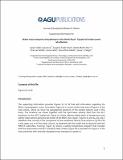Por favor, use este identificador para citar o enlazar a este item:
http://hdl.handle.net/10261/272067COMPARTIR / EXPORTAR:
 SHARE SHARE
 CORE
BASE CORE
BASE
|
|
| Visualizar otros formatos: MARC | Dublin Core | RDF | ORE | MODS | METS | DIDL | DATACITE | |

| Título: | Water Mass Transports and Pathways in the North Brazil-Equatorial Undercurrent Retroflection |
Autor: | Vallès Casanova, Ignasi Berenguer CSIC ORCID ; Fraile-Nuez, Eugenio ; Martín-Rey, Marta CSIC ORCID; van Sebille, E.; Cabré Albos, Anna; Olivé Abelló, Anna CSIC ORCID ; Pelegrí, Josep Lluís CSIC ORCID | Fecha de publicación: | may-2022 | Editor: | American Geophysical Union | Citación: | Journal of Geophysical Research - Part C - Oceans 127(5): e2021JC018150 (2022) | Resumen: | The equatorial retroflection of the North Brazil Current (NBC) into the Equatorial Undercurrent (EUC) and its posterior tropical recirculation is a major regulator for the returning limb of the Atlantic Meridional Overturning Circulation. Indeed, most surface and thermocline NBC waters retroflect at the equator all the way into the central and eastern Atlantic Ocean, before they recirculate back through the tropics to the western boundary. Here, we use cruise data in the western equatorial Atlantic during April 2010 and reanalysis time series for the equatorial and tropical waters in both hemispheres in order to explore the recirculation pathways and transport variability. During the 1998–2016 period, the annual-mean EUC transports 15.1 ± 1.3 Sv at 32°W, with 2.8 ± 0.4 Sv from the North Atlantic and 11.4 ± 1.3 Sv from the South Atlantic. At 32°W most of the total EUC transport comes from the western boundary retroflection south of 3°N (7.2 ± 0.9 Sv), a substantial fraction retroflects north of 3°N (5.6 ± 0.4 Sv), and the remaining flow (2.3 Sv) joins through the interior basin. The South Atlantic subtropical waters feed the EUC at all thermocline depths while the North Atlantic and South Atlantic tropical waters do so at the surface and upper-thermocline levels. The EUC transport at 32°W has a pronounced seasonality, with spring and fall maxima and a range of 8.8 Sv. The 18 yr of reanalysis data shows a weak yet significant correlation with an Atlantic Niño index, and also suggests an enhanced contribution from the South Atlantic tropical waters during 2008–2016 as compared with 1997–2007 | Descripción: | 21 pages, 10 figures, 3 tables, supporting information https://doi.org/10.1029/2021JC018150.-- Data Availability Statement: The hydrographic and biogeochemical cruise data is available at the Clivar and Carbon Hydrographic Data Office (Rios et al., 2012) and the hydrographic and velocity data for leg 1 of the cruise is available at Zenodo (https://doi.org/10.5281/zenodo.6359412; Pelegrí et al., 2022) | Versión del editor: | https://doi.org/10.1029/2021JC018150 | URI: | http://hdl.handle.net/10261/272067 | DOI: | 10.1029/2021JC018150 | E-ISSN: | 2169-9291 |
| Aparece en las colecciones: | (IGEO) Artículos (ICM) Artículos (IEO) Artículos |
Ficheros en este ítem:
| Fichero | Descripción | Tamaño | Formato | |
|---|---|---|---|---|
| Valles_et_al_2022.pdf | 2,65 MB | Adobe PDF |  Visualizar/Abrir | |
| Valles_et_al_2022_suppl.pdf | 3,32 MB | Adobe PDF |  Visualizar/Abrir |
CORE Recommender
SCOPUSTM
Citations
6
checked on 18-abr-2024
WEB OF SCIENCETM
Citations
6
checked on 28-feb-2024
Page view(s)
74
checked on 24-abr-2024
Download(s)
78
checked on 24-abr-2024
Google ScholarTM
Check
Altmetric
Altmetric
Este item está licenciado bajo una Licencia Creative Commons

